8 proven eCommerce marketing automation strategies and tools
Updated on 24 Jun 2025
Automation is an essential part of eCommerce marketing that helps teams reduce manual tasks, work more efficiently, and maximize their marketing spend.
However, automation is also challenging for lots of companies, as many aspects of marketing can potentially be automated, including:
- Email flows.
- Campaigns on messaging channels like SMS and WhatsApp.
- Banners, messaging, and product recommendations shown on a website or mobile app.
- And much more.
The problem is that very few tools can automate all of these processes. As a result, companies often get stuck trying to integrate disconnected systems while essential details—like actually building the right automation strategies—slip through the cracks.
But with the right marketing automation software, you can build and automate campaigns across all channels you’re using and personalize them to each customer’s behaviors, interests, and preferred touchpoints.
In this guide, we’ll discuss everything you need to know about eCommerce marketing automation.
- The benefits of eCommerce marketing automation
- 8 proven eCommerce marketing automation strategies (with real-life examples)
- 6 best marketing automation tools for eCommerce stores (& how to choose the right one)
We’ll also use Insider—our platform for creating individualized, cross-channel customer experiences—to show how you can implement key automation strategies for your business.
Insider can help you build and automate consistent, personalized journeys across all touchpoints customers have with your brand—from your website and mobile app to channels like email, SMS, and WhatsApp. Visit our website or schedule a demo with our team to learn more.
The Benefits of eCommerce Marketing Automation
Automating different aspects of your eCommerce marketing comes with five BIG benefits:
- Save time by removing repetitive tasks. Marketing stacks have grown in complexity to the point where businesses need entire operations teams to ensure everything runs smoothly. Automating manual work helps you reduce some of that complexity, avoid mundane work, and focus on more impactful tasks.
- Reduce human errors. This stems directly from the previous point. Organizations that set up their automations correctly see fewer errors, as processes become less reliant on people’s memory and concentration.
- Send contextual messages in real-time. Many marketing messages must be sent in response to various events—purchase confirmations, price drop alerts, event reminders, and so on. This is only possible with rule-based automations set up in advance.
- Maximize your marketing effort and budget. Automation tools can help you deliver personalized messaging, content, and product recommendations to the right people, at the right times. As a result, you can make the most out of your marketing investments by increasing relevance and conversion rates.
- Implement a consistent, cross-channel marketing strategy. Today’s customers use various devices, platforms, and apps during their journeys. It’s impossible to provide a great shopping experience and nurture customer relationships at scale without automating (and personalizing) the messages users are shown at each touchpoint.
Additionally, marketing automation can be beneficial for cross-team collaboration. For example, a good automation strategy can help marketing and sales teams stay on the same page regarding the quality and pipeline stage of each lead.
To enhance this process, businesses might choose to hire expert ecommerce developers who can integrate advanced automation tools tailored to their specific needs. This ensures not only improved collaboration between teams but also a more streamlined approach to managing and nurturing leads.
8 proven eCommerce marketing automation strategies (with real-life examples)
In this section, we’ll break down the best automation strategies you can use to streamline operations and improve key metrics like conversion rates, average order value (AOV), and customer acquisition costs (CAC).
You’ll also see examples of how our clients used many of these strategies and the results they saw after implementing them.
1. Personalized email onboarding journeys
Automated welcome email sequences (sometimes called lead nurture campaigns) are a classic eCommerce marketing strategy.
The goal is simple—getting email subscribers to make their first purchase as quickly and cheaply as possible.
While you can create the same onboarding flow for all subscribers, personalizing the onboarding to each user segment can yield much better results. For example, you can:
- Build a separate onboarding journey for users actively browsing a specific category on your site or app.
- Create different flows depending on the source that led new leads to your site (e.g., social media, email newsletters, in-person stores, and so on).
- Show different product recommendations in your onboarding to users for different locations (e.g., cold vs. warm countries).
For instance, Remix used a three-step automated email flow to onboard and nurture leads.
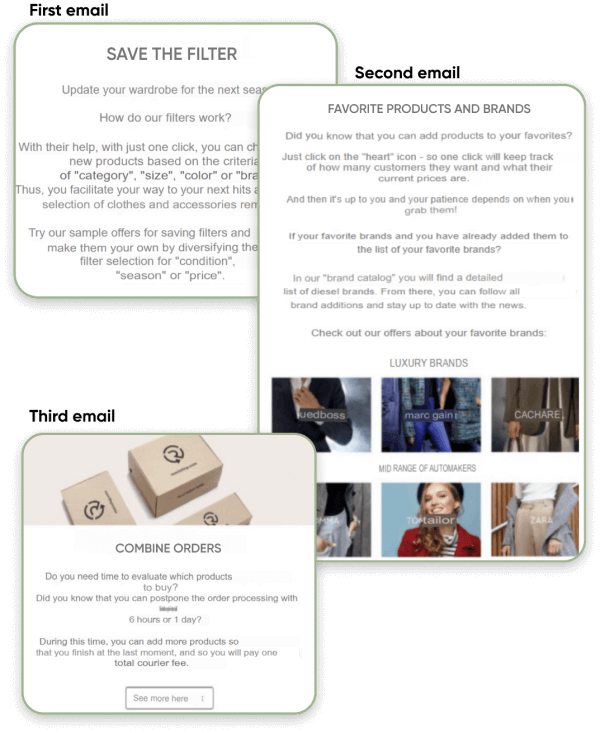
First, if new subscribers didn’t make a purchase one week after registering, Remix sent an email prompting them to save their preferred search filters.
Then, after a few days, a second email was triggered, showcasing a list of brands available on the site and how to mark one as a favorite. The final email contained useful details about combining orders and saving money on shipping.
This campaign resulted in a 104% jump in first purchases compared to the previous quarter.
2. Cart abandonment reminders
Cart abandonment campaigns are another eCommerce classic.
Again, the concept is simple—you take a segment of users who added an item to their carts without completing their purchase and remind them to do so. You can even add discounts and limited-time offers to induce action.
These automated reminders can be sent on various channels. For example, some of the channels Insider offers natively are:
- Email and SMS: These are the most widely-used channels for eCommerce stores globally. You can use one or the other or build a synchronized journey across both touchpoints.
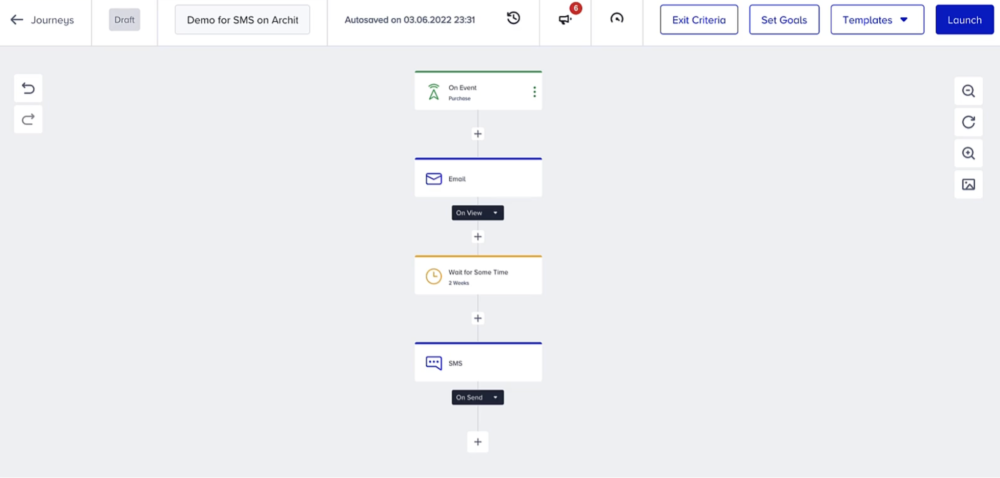
- WhatsApp: Depending on your country and user base, WhatsApp may be a better option than email and SMS. Insider is one of the few eCommerce personalization tools that supports WhatsApp as a native channel, so you can easily include it in your digital marketing strategy.
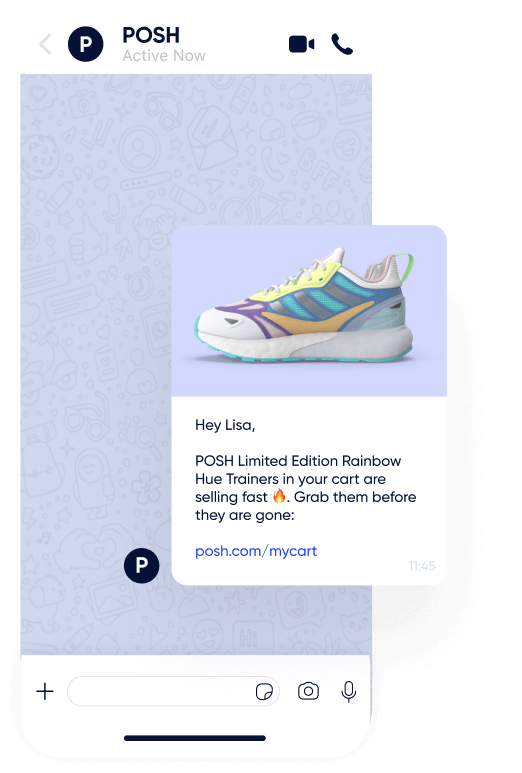
- Web Push: A highly underrated channel for cart abandonment, Web Push has a massive benefit because there’s no additional cost involved in sending push notifications, unlike SMS and WhatsApp messages or retargeting ads. Fashion brand Marks & Spencer used Insider’s push notifications to achieve a 15.1% cart recovery rate (compared to the 3% industry average for abandoned cart emails).
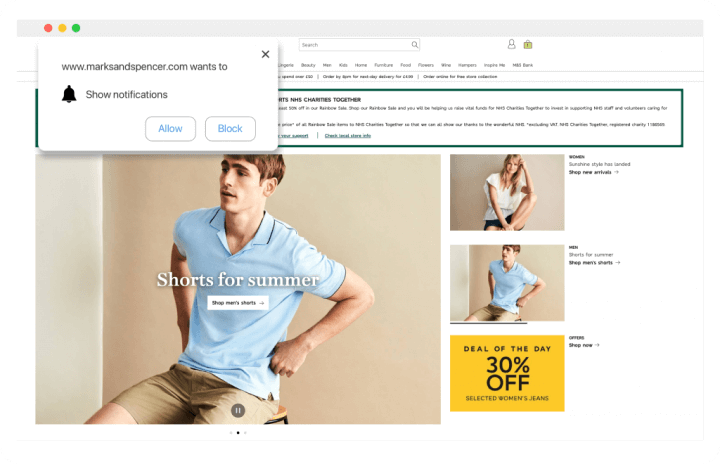
3. Automated price drop and inventory alerts
Sending price drop and inventory alerts is a great way to engage:
- Potential new customers on the verge of making their first purchase.
- Customers who are interested in a specific product (or category).
- Customers who have a high discount affinity.
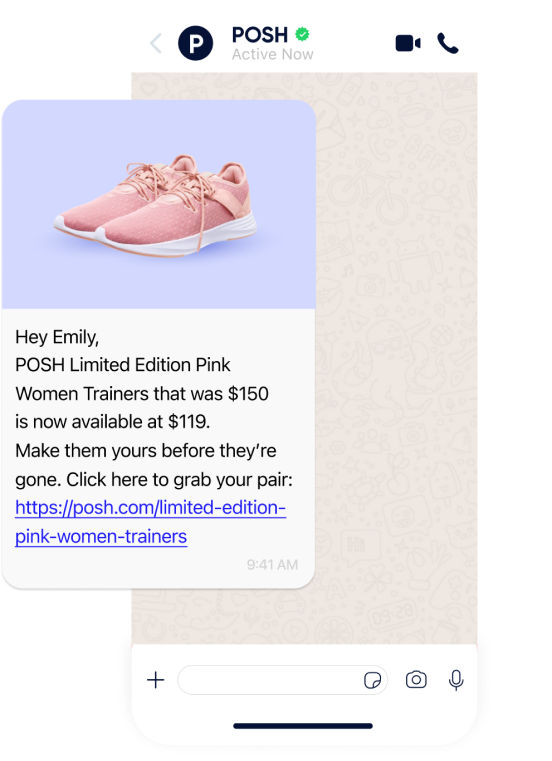
For example, you can easily set up Insider to send an email, SMS, WhatsApp message, or Web Push notification to your subscriber list base when your best-selling items are back in stock.
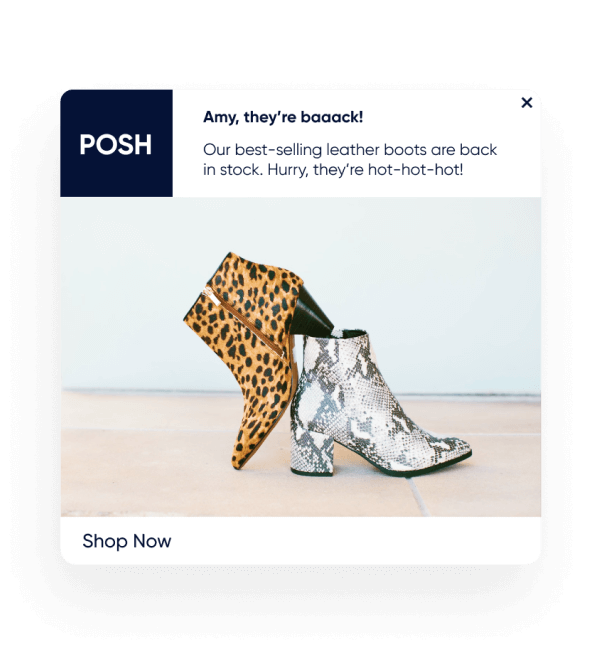
Or, you can narrow down your audience with our AI-powered predictive segments and price drop alerts only to customers with a high discount affinity.
That way, you’re showing discounts only to the people most likely to engage with them, instead of wasting them on users who would’ve bought a product anyway.
4. Social media and search ad remarketing
Retargeting is showing ads to users who have visited your site, mobile app, or social media profiles.
These ads are typically shown on social media apps like Facebook, Instagram, and TikTok, on Google search, or on Google’s Display Network.
While powerful, digital ads can get expensive, so it’s crucial to make the most out of your retargeting efforts.
That’s why Insider lets you use our predictive audiences (which we showed in the previous section) for more precise ad targeting.
In fact, Monster Notebook used this strategy to improve the results of their Google Display retargeting ads.
First, they combined our predictive ad audiences with data from the Google ads they were running. Then, they integrated these audiences into 10 ad groups and targeted them using two remarketing lists. Over the 13-month period in which Monster Notebook used this strategy, they saw a:
- 65% reduction in cost per conversion.
- 440% increase in conversion rates.
- 10% boost in AOV.
- 2.9X improvement in return on ad spend.
5. Chatbot automations
For years, eCommerce brands have used chatbots as a 24/7 customer service channel and on-site conversion tool. And today’s advances in AI and natural language processing have increased the power of chatbots even more.
For example, many chatbots can answer typical questions like “Where’s my order?” or “What are your shipping options?” instantly, without requiring a live agent to intervene. They can also recognize more complex queries and direct users to pre-set flows to resolve their issues.
Here are a few chatbot automation ideas that can help you improve product discovery and increase your site’s conversion rate:
- Send a limited-time discount to users on a certain product page.
- Remind website visitors about your free shipping policy.
- Nudge users to your best-selling items.
You can easily implement these and many other chatbot automation tactics with a solution like MindBehind.
6. On-site personalization
The higher your conversion rates, the more you’re making out of the budget spent to bring visitors to the site. That’s why boosting conversion rates is essential for maximizing your marketing budget and improving profit margins.
One of the best ways to optimize your conversions is by automatically personalizing your store’s content, messaging, and product recommendations to each visitor’s behaviors and interests.
For example, Insider’s personalization engine lets you:
- Change the banners visitors are shown based on their behaviors and interests. Yves Rocher increased website conversion rates by 5% by showing different banners to frequent shoppers and first-time visitors who were browsing for a quick buy.
- Shuffle how categories are presented in your navigation with our Category Optimizer. Samsung used this tactic to drive a 10% conversion rate uplift during the launch campaign for the Galaxy Note 9.
- Show dynamic product recommendations with our AI-powered Smart Recommender. AVON used our Smart Recommender to show highly-relevant and contextual products to online shoppers, resulting in an 11% AOV increase and a 13% boost to their CTR.
For more details on this topic, check out our guide to maximizing revenue with website personalization.
7. Customer re-engagement and churn prevention automations
Early churn is among the biggest issues for eCommerce businesses today. That’s why having a way to detect which customers are about to churn and automatically engage them in time is essential for improving revenue and LTV.
Insider helps you do this with our Recency, Frequency, and Monetary value (RFM) segmentation.
First, RMF detects users who were active in the past but have recently reduced their browsing and transaction frequency. Then, our platform shows you where these drop-offs in activity occur and lets you create automated re-engagement campaigns.
Here are two examples of companies that used this strategy to re-engage dormant customers and prevent churn:
- Pierre Cardin used our AI-powered predictive segmentation to break down their ad audiences based on factors like their risk of churning. Then, they ran targeted online campaigns, which resulted in a 445% uplift in conversion rates, a 164.83% boost in return on ad spend, and a 67.95% reduction in cost per acquisition.
- HipVan created unique automated flows for users based on the stage of their journey. Their main goal was re-engaging different categories of users. By creating automated cross-channel journeys for each segment, HipVan achieved a 46.7% conversion rate uplift compared to their site average for the previous quarter.
8. Automated cross-channel customer journeys
This final strategy is more complex to implement. However, when done currently, it can transform your customers’ experience into a consistent, individualized journey across all touchpoints with your brand.
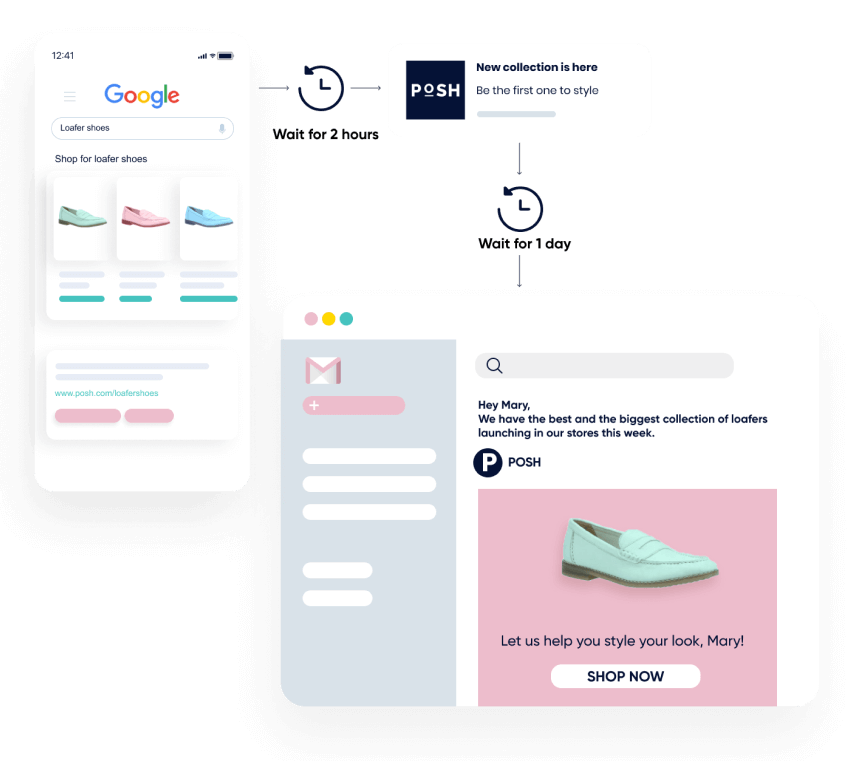
To implement this strategy, you’ll need a cross-channel customer journey builder, like Insider’s Architect.
Architect lets you create and automate cross-channel customer journeys, A/B test different paths in them, and analyze their results.
For example, say you have a user segment with an affinity for discounts and an interest in certain categories and price ranges. You can have Insider send them personalized emails three hours after they browsed your online store without buying.
If that doesn’t work, you can follow up with SMS or WhatsApp messages containing dynamic product recommendations and a discount code. Finally, you can instruct Insider to wait until there’s a price reduction and re-engage them on the channel most likely to help you reach your goals (thanks to our AI-powered next-best channel predictions).
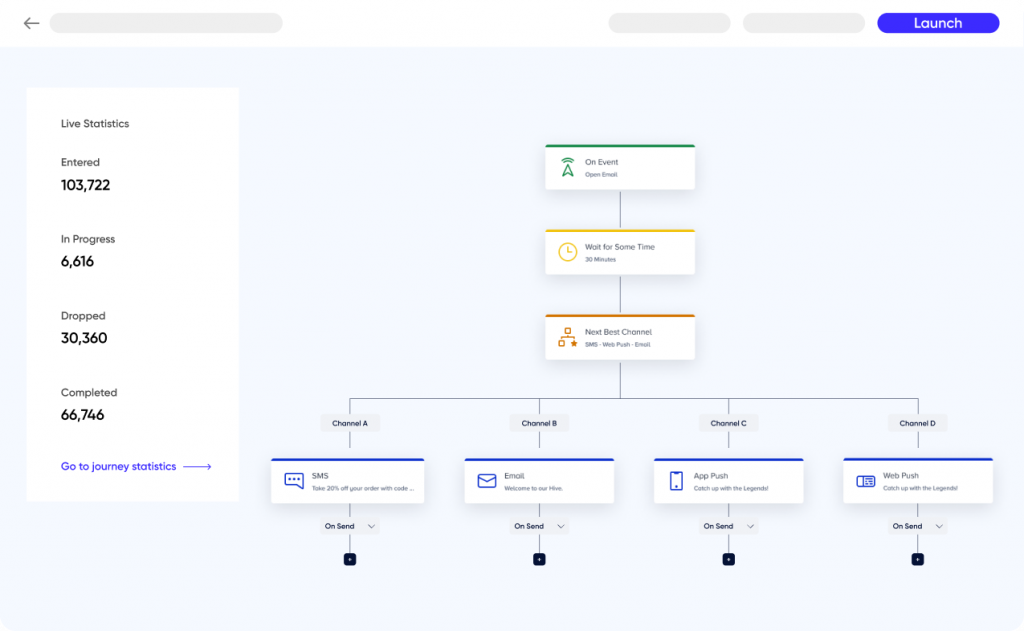
In fact, many of the companies we looked at earlier used Architect to implement their automated workflows:
- Remix used it to create over 50 customer journeys with separate coupon tiers for their on-site, email, and web push channels.
- HipVan used it to reach each of their user segments via channels like email and web push.
- Yves Rocher used it to orchestrate their abandonment journey across web push and social media ads.
For a more detailed example, you can check out our case study with fashion brand NA-KD. They used Insider to deliver personalized experiences to customers across email, SMS, and web push, resulting in a 25% increase in LTV and 72x return on investment (ROI) over the first 12 months.
6 best eCommerce marketing automation tools (& how to choose the right one)
As you can tell, successful marketing automation relies heavily on software. At the same time, there are many versatile solutions for automating different aspects of your eCommerce marketing, including:
- Email and SMS marketing tools.
- Personalization platforms.
- WhatsApp marketing tools.
- Push notification software.
- Landing page builders, and more.
There’s no one-size-fits-all when it comes to choosing the right tool (or set of tools) for you. That’s why we’ll start this section by discussing the three factors you need to evaluate when comparing the different options.
3 key factors for choosing the right eCommerce marketing automation software
Outside of common-sense considerations like budget and business needs, there are three essential factors to consider when comparing marketing automation tools for your eCommerce store:
- Supported channels. The more channels a tool supports, the easier it will be for you to implement automation strategies. For example, say your main channels are your website, email, and SMS. If you get a tool that can do email and SMS marketing, while also offering website personalization, you can automate most of your marketing work from a single place. In contrast, using two or three solutions would require complex integrations and more maintenance.
- Key use cases. Some tools are built for relatively simple use cases, like automating campaigns on a single channel. Others support more complex tasks, like cross-channel journey automation, churn prevention, and dynamic product discovery. Again, consider which marketing tasks you actually want to automate and find a tool that helps with most (or preferably all) of them.
- Flexibility and integrations. Even if you get an all-in-one marketing solution, you’ll still need it to work well with the rest of your eCommerce stack, like your website platform, analytics tools, merchandising software, and so on. That’s why it’s vital to get an automation tool with flexible APIs and pre-built integrations. This ensures critical data can be shared between systems so that automations can run smoothly.
6 best eCommerce marketing automation tools
Before we dive into the best automation solutions, two quick notes:
- The list below starts with more flexible solutions for implementing automation strategies on various channels (like Insider) and ends with simpler, channel-specific automation tools (like Mailchimp and ActiveCampaign).
- All tools below can be easily integrated with popular eCommerce platforms and CMSs, like Shopify, BigCommerce, and so on. They also have integrations with other marketing tools, so you don’t have to worry too much about fitting them into your stack.
#1 Insider
- Supported channels: Web (on-site), mobile apps, web push notifications, email, SMS, WhatsApp, Facebook Messenger, Instagram, LINE, social media and search ads, and more.
- Key use cases: Creating automated omnichannel marketing campaigns, personalizing every customer touchpoint, A/B testing, and aggregating customer data to create 360-degree customer profiles.
Insider is our AI-native omnichannel experience and customer engagement platform.
As we showed throughout this guide, Insider offers many ways to automate marketing messages, content, and recommendations across all channels you’re using. In fact, our omnichannel automation tool is essential for many of our eCommerce customers:
“Insider’s journey orchestration solution, Architect, has been a boon for us as it has enabled us to scale up our cross-channel marketing strategy by leaps and bounds. Through Architect, we were able to create orchestrated journeys across channels like web push, email, and SMS and integrate that with our existing mobile app communication. Architect’s AI-powered Next Best Channel capability has been super critical in taking our engagement game up further because it suggests the ideal channel to communicate with our customers.”
Additionally, Insider’s combination of broad channel support, personalization functionalities, and omnichannel automation features lets you save time, effort, and resources by:
- Simplifying your marketing stack, as you can use one solution for all your marketing channels.
- Streamlining your workflow, as you can implement your automation strategies from one place.
Insider is also ranked as a leading personalization engine in Gartner’s Magic Quadrant and as the best personalization software in G2’s Grid.
Besides the automation use cases we explored earlier, Insider can also help you:
- Consolidate your customer data and build unified, 360-degree customer profiles. This is possible thanks to our Actionable Customer Data Platform (CDP), which can aggregate data from online or offline sources, like CRMs, point of sale (POS) devices, customer service software, analytics tools, and so on. If you’re not familiar with CDPs and their importance, check out our article on the top 7 CDPs.
- A/B test different messages or customer journey flows. With Insider, you can easily test which version of a marketing message brings better results. You can also compare entire flows against each other — for example, you can determine if following up purchase confirmation emails with an SMS leads to more cross-sells and upsells than, say, web push notifications or WhatsApp messages.
- And much more!
Finally, Insider’s extensive template library and experienced support team will help you implement the right automation strategies for your business as fast as possible.
For an in-depth look at how Insider works, book a live demo with our team.
#2 Omnisend
- Supported channels: Email, SMS, and Web Push notifications.
- Key use cases: Creating automated email and SMS marketing campaigns, building forms and pop-ups, and retargeting users with push notification software.
Omnisend is an eCommerce automation platform for email, SMS, and web push. Marketing teams use it to run synchronized SMS and email marketing campaigns, as well as retarget customers with web push notifications and social media ads (via the audience sync feature). Besides these core capabilities, Omnisend also has a popup and form builder.
Note: Click here to see how Omnisend compares to Insider
#3 Klaviyo
- Supported channels: Email and SMS.
- Key use cases: Automating email and SMS marketing campaigns, building signup forms, and creating real-time customer profiles.
Klaviyo is a marketing platform that helps teams create and automate email and SMS marketing campaigns. It has features for creating customer profiles and segmenting users based on preset or custom properties and attributes. Some of its other campaign management features include send-time optimization and a drag-and-drop builder.
Note: Click here to see how Klaviyo compares to Insider
Learn more: 11 Best Klaviyo competitors & alternatives for all business types
#4 Drip
- Supported channels: Email and on-site.
- Key use cases: Creating automated email campaigns, building personalized on-site experiences, and automating multi-channel marketing campaigns.
Drip is an eCommerce marketing automation platform for creating email and on-site campaigns. It has a drag-and-drop editor for building automated emails and omnichannel campaigns, although those have to be set up via integrations with other tools. Drip also offers dynamic segmentation features for organizing email lists and sending targeted messages.
#5 ActiveCampaign
- Supported channels: Email and SMS
- Key use cases: Creating automated email campaigns, building landing pages, tracking on-site behaviors, and monitoring sales leads.
ActiveCampaign is a unique entry to this list, as it combines features for both marketing and sales teams. The platform offers standard email marketing automation capabilities, like autoresponders, scheduling, and transactional emails. At the same time, it also has a CRM and a lead-scoring feature for sales teams.
#6 Mailchimp
- Supported channels: Email.
- Key use cases: Creating automated email campaigns, optimizing email copy, and designing landing pages.
Mailchimp is one of the pioneering email marketing tools for small businesses. The company was acquired by Intuit in 2021, but the email marketing product still exists today. Besides the standard email features, Mailchimp offers AI-powered copy suggestions and a customer journey builder for setting up automated workflows.
Boost your conversions, AOV, and LTV with Insider
Insider can help you create and automate personalized, cross-channel campaigns across all customer touchpoints—from your website and mobile app to channels like email, SMS, WhatsApp, Facebook Messenger, and more.
Our enterprise marketing platform can also:
- Aggregate all customer data—from CRMs, CMSs, analytics tools, and any other online or offline source—into one place.
- Create unified, 360-degree profiles of all your customers that reveal their behaviors, interests, and preferred touchpoints.
- Predict behaviors with our AI-powered intent engine, like how much different segments are projected to spend and how likely they are to buy or churn.
Lastly, our easy channel integrations, experienced customer support team, and extensive templates will help you implement the right automation strategies and start improving revenue, AOV, and LTV as fast as possible.
Click here to book a demo with our team and learn how Insider can help you reach your business goals.
FAQs
eCommerce marketing automation is a system of tools automating marketing tasks for online retailers. It includes email campaigns, customer segmentation, personalized recommendations, and cart recovery. This enhances efficiency and delivers tailored shopping experiences to boost sales.
Start with customer segmentation for targeted messaging. Automate email campaigns, product recommendations, and cart recovery. Analyze campaign performance and automate social media posts. Collect feedback and implement retention strategies for lasting customer relationships.
The best platform for eCommerce marketing largely depends on your specific needs, such as your target audience, the size of your business, and your budget. Here are some popular platforms to consider:
– Facebook and Instagram are best for visual products, targeting consumers through interest-based advertising, and influencer marketing. These platforms have massive user bases and robust ad targeting options. Instagram is especially great for visually appealing products like fashion, beauty, and lifestyle items.
– Google Ads are best for search-driven eCommerce and driving high-intent traffic. Google Ads helps capture potential customers who are actively searching for products like yours.
-TikTok is best for trend-driven marketing, especially ones targeting younger audiences. It has become one of the fastest-growing platforms and has a strong potential for organic reach, especially with creative video content.
– Pinterest is best for niche products, especially for DIY, home decor, fashion, and beauty. It’s highly visual and has a strong “discovery” element.
– YouTube is best for video marketing, product tutorials, and influencer partnerships. It’s especially effective for showcasing product benefits, unboxing, and customer testimonials.
– Amazon Advertising is best for selling on Amazon and driving traffic to Amazon listings. If you sell on Amazon, using Amazon’s advertising system can directly help increase visibility and sales within the platform.
Again, the best advertising platform for eCommerce depends on your goals, target audience, and product type. However, some platforms consistently stand out due to their powerful tools, vast audience reach, and proven track records for driving sales including:
– Facebook and Instagram ads, which are ideal for building brand awareness and retargeting, especially for visually appealing products.
– Google ads, which is great for capturing demand when users are actively searching for products.
TikTok ads, which can help you reach younger audiences with engaging content-driven marketing.
-YouTube ads, which are also fantastic for building brand awareness.
– Amazon ads, which are ideal for Amazon sellers or businesses selling physical products that can be purchased directly through Amazon.
For more niche use cases, Pinterest, Snapchat, and LinkedIn ads can also be beneficial for increasing brand awareness and driving sales.



















